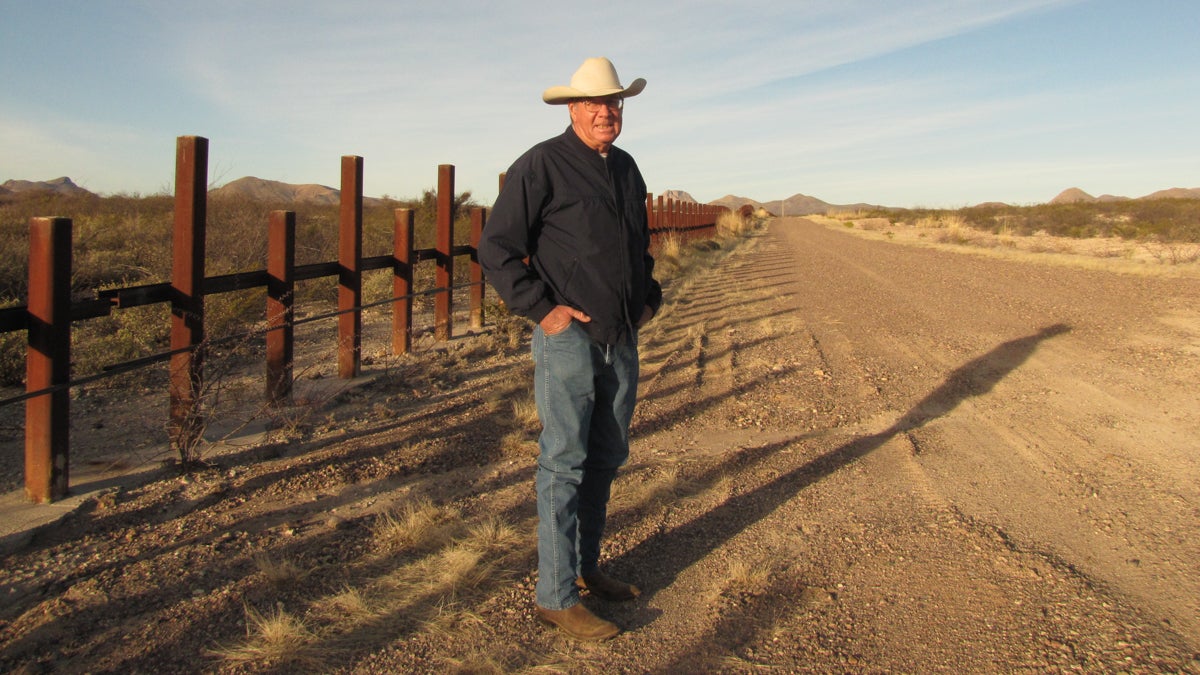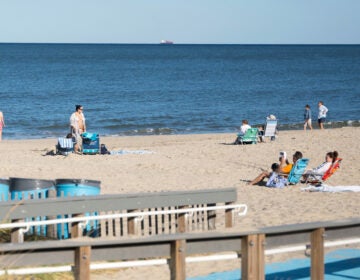Why Trump’s ‘big, beautiful wall’ might not be great for wildlife
Listen 7:10
Bill McDonald, rancher conservationist and Executive Director of the Malpai Borderlands Group, stands at the U.S./Mexico border near Douglas, Arizona (Maya Springhawk Robnett/for WHYY)
Conservationists are worried about stopping non-human traffic at the border.
The U.S./Mexico border region is one of the most diverse wildlife areas in the nation, with about 600 different kinds of animals. But that isn’t obvious at first listen; it’s quiet in the Sonoran desert.
The vast expanse of sand and occasional cacti straddles the state of Sonora in Mexico and the southern border of Arizona. There are all sorts of hidden species staying in the shadows and keeping to the brush—from Gila monster lizards to coyotes to bark scorpions. The loudest animal sound you might hear is the braying of a burro, but the wild donkeys are skittish of people, too.
To meet one, I visit Laura Merrill on her farm on the outskirts of Yuma, Arizona. She adopts the burros as pets.
When Merrill took one burro, Sugar, out of the pen, Sonny, the brown one with the white legs, was left behind.
Sonny started whining and running back and forth along the gate, looking for a way out to get to her companion.
That behavior is indicative of what wildlife experts say happens when animals encounter a barrier: they don’t know how to get around it. That’s why the proposed uninterrupted, concrete wall along the U.S./Mexico border worries conservationists so much. Being cut off from other animals, food and water leads to problems.

This isn’t a new concern for conservationists. In one case reported by the Sierra Club, a cougar crossed the U.S./Mexico border before a section of the existing wall was erected. A male cougar’s territory can be dozens of miles wide. So when the wall went up, its habitat was abruptly cut in half.
Near Douglas, Arizona on a recent foggy morning, I stood with three ranchers at the border.
Shoulder-high metal sculptures (called a Normandy barrier) cut through the landscape of blue mountains, greenery, and beige land. Made from posts that look like railroad tracks set in X-shapes, they allow most animals through, but it keeps vehicles out and keeps cattle in.
Warner Glenn, an 81-year-old rancher, put his hand on the metal and looked out past the international boundary.
“If you jump over this barrier,” he said, “the first step you’d be still in the U.S., but from then on, you’d be in Mexico.”
Glenn and his daughter, Kelly Glenn-Kimbro, own the land on the American side. The ranch has been in the family for more than six decades. They’re Trump supporters but that doesn’t mean they agree with all of his policies.
“We don’t want a wall. It isn’t going to stop 10 people,” Glenn-Kimbro explained. “We saw a funny thing at Walmart in Douglas right after Trump was elected. My daughter and I saw a truck with Sonora license plates, going to Mexico, with twelve ladders on it. And we were like, ‘Oh my gosh! This man’s going into business!'”
Glenn-Kimbro say once the wall goes up, he’ll likely be selling those ladders to people in Mexico who want to go over the wall into the U.S.
People can climb over or tunnel under barriers, but most animals won’t be able to dig under the kind of deep foundation needed for a concrete wall. Bill McDonald heads a ranchers’ conservationist outfit in the Douglas area. The group is concerned that the proposal for an ‘impenetrable” concrete wall—which President Donald has said could be as high as forty feet tall—will block natural migration corridors.
“I mean, there’s no question about it. There’s a big difference between a barrier that has gaps in it that allows wildlife to go through,” he gestured to the Normandy barrier, “and one that doesn’t. I mean, some of them can, you know, fly over it. But if they don’t have wings, they’re not going to get over this.”
Even some animals with wings won’t be able to cross. The pygmy owl, an endangered bird small enough to sit in the palm of a hand, typically doesn’t fly higher than 15 feet.
In addition to mountains, sand dunes and other natural barriers, about 300 of the 375 miles of Arizona’s border already have some kind of manmade barrier on them. Wildlife experts say a continuous wall would be even worse.
When an animal is injured or struggling near the border, it’s often a volunteer like Cecilia Vigil, an Arizona Western College biology professor, who comes to the rescue.
Vigil cared for a red-tailed hawk that was brought in with symptoms of poisoning. People trying to cross the border disrupt habitats and leave behind all sorts of animal hazards, including trash and plastic water bottles. Vigil said she may end up with more animals that need help if President Trump’s plan becomes concrete.
“You put those walls up and they can’t cross-pollinate,” she said. “They can’t pass those genes and mix them up. Once you lose that biodiversity, it affects the population in very devastating ways,” Vigil said.
Vigil was referring to fragmentation. That’s a disruption where animal groups are split, making it difficult for them to find water or food where they used to. Finding a mate outside an immediate family group gets harder, too; displaced animals can begin to inbreed and that weakens the population.

The U.S. Border Patrol’s mission is to stop illegal immigrants and terrorists from entering the country. But Bryon Strom, a Border Patrol agent in the Yuma Sector, said agents look out for animals, too. He said he didn’t think the current barriers do any harm.
“Do I think that we stop wildlife from migrating back and forth from the United States to Mexico? No, I don’t,” Strom shook his head. “Where there’s a will, there’s a way. And where we’ve done environmental impact studies, the right fence is in the right place to allow that to happen.”
More than two dozen environmental laws were waived to put up the existing walls, barriers, and fences. And wildlife watchers like Dan Millis with the Sierra Club in Tucson want more rigorous studies.
“For the Border Patrol to say that ‘where there’s a will, there’s a way,’ is really emblematic of how people respond to the wall, not wildlife. Mountain lions don’t throw ropes over the wall. Deer are not able to construct a ladder and go over the wall,” Millis said.
Officials with the U.S. Border Patrol and the U.S. Game & Fish Department said they expect to have a say in the construction of any new barrier on the border and those same officials seemed confident it won’t be a solid, uninterrupted concrete wall.
So until it’s set in stone (or cement), the animals of the border—for the most part—remain bi-national citizens.
WHYY is your source for fact-based, in-depth journalism and information. As a nonprofit organization, we rely on financial support from readers like you. Please give today.






